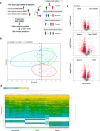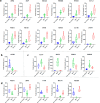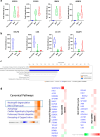Longitudinal Assessment of Nasopharyngeal Biomarkers Post-COVID-19: Unveiling Persistent Markers and Severity Correlations
- PMID: 39392878
- PMCID: PMC11536464
- DOI: 10.1021/acs.jproteome.4c00536
Longitudinal Assessment of Nasopharyngeal Biomarkers Post-COVID-19: Unveiling Persistent Markers and Severity Correlations
Abstract
SARS-CoV-19 infection provokes a variety of symptoms; most patients present mild/moderate symptoms, whereas a small proportion of patients progress to severe illness with multiorgan failure accompanied by metabolic disturbances requiring ICU-level care. Given the importance of the disease, researchers focused on identifying severity-associated biomarkers in infected patients as well as markers associated with patients suffering long-COVID. However, little is known about the presence of biomarkers that remain a few years after SARS-CoV-2 infection once the patients fully recover of the symptoms. In this study, we evaluated the presence of persistent biomarkers in the nasopharyngeal tract two years after SARS-Cov-2 infection in fully asymptomatic patients, taking into account the severity of their infection (mild/moderate and severe infections). In addition to the direct identification of several components of the Coronavirus Infection Pathway in those individuals that suffered severe infections, we describe herein 371 proteins and their associated canonical pathways that define the different adverse effects of SARS-CoV-2 infections. The persistence of these biomarkers for up to two years after infection, along with their ability to distinguish the severity of the infection endured, highlights the surprising presence of persistent nasopharyngeal exudate changes in fully recovered patients.
Keywords: COVID-19; SARS-CoV-19; biomarkers; proteomics.
Conflict of interest statement
The authors declare no competing financial interest.
Figures





References
-
- Narayanan S. A.; Jamison D. A. Jr.; Guarnieri J. W.; Zaksas V.; Topper M.; Koutnik A. P.; Park J.; Clark K. B.; Enguita F. J.; Leitão A. L.; et al. A comprehensive SARS-CoV-2 and COVID-19 review, Part 2: host extracellular to systemic effects of SARS-CoV-2 infection. Eur. J. Hum. Genet. 2024, 32 (1), 10–20. 10.1038/s41431-023-01462-1. - DOI - PMC - PubMed
-
- Yang X.; Yu Y.; Xu J.; Shu H.; Xia J.; Liu H.; Wu Y.; Zhang L.; Yu Z.; Fang M.; et al. Clinical course and outcomes of critically ill patients with SARS-CoV-2 pneumonia in Wuhan, China: a single-centered, retrospective, observational study. Lancet Respir. Med. 2020, 8 (5), 475–481. 10.1016/S2213-2600(20)30079-5. - DOI - PMC - PubMed
MeSH terms
Substances
LinkOut - more resources
Full Text Sources
Medical
Miscellaneous

